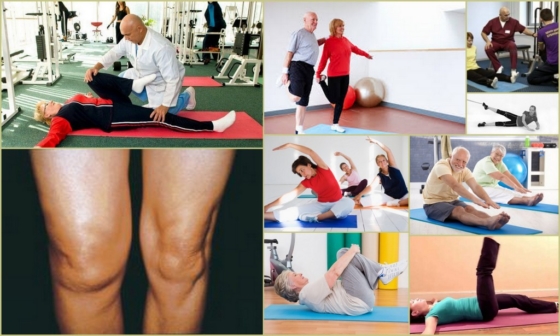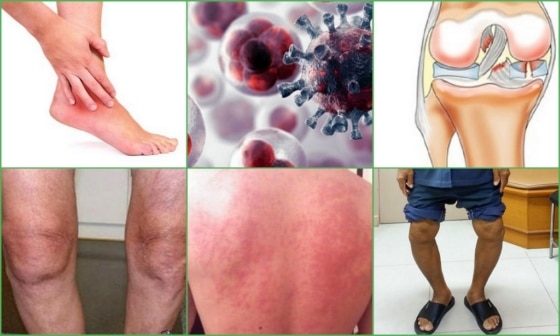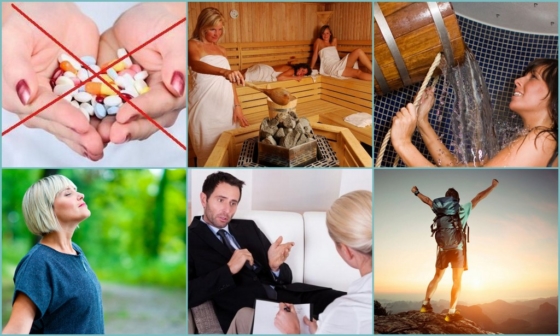Trainers are an effective way to treat osteoarthritis. They help restore mobility after injury or surgery.
- Can you train as a bodybuilder if you have osteoarthritis?
- How osteoarthritis develops when exercising in the gym
- Indications and contraindications for exercises
- Features of Bubnovsky exercises
- Rules for conducting therapeutic exercises:
- Why is cycling the best?
- Versatile equipment: the elliptical trainer
- indications
- Training
- The most common physiotherapeutic treatments for gonarthrosis are.
- CONTACT
- General principles of physical therapy for gonarthrosis
- Main recommendations for physical therapy
- Suggestions for combining with exercises in the gym
- Effective exercises for osteoarthritis
- Equipment for passive joint training
- Kinetec' devices
- Artromot' devices
- Active joint training device
- exercise bike
Can you train as a bodybuilder if you have osteoarthritis?
Osteoarthritis often forces those affected to give up their sport. Osteoarthritis patients will certainly refrain from jogging and jumping, climbing and horseback riding, since violent movements can further damage the cartilage. Orthopedic surgeons often allow bodybuilders to engage in sports provided certain rules are followed.
Osteoarthritis is a degenerative change in the structure of cartilage that causes the cartilage to lose its elasticity and affects the other components of the joint: ligaments, bones, muscles and synovial fluid. One of the causes of cartilage wear is frequent, monotonous movements. This happens in bodybuilding, which is why weightlifters are particularly at risk.
One of the triggers, along with high blood pressure and high cholesterol, is smoking. Smokers with a history come to the gym frequently, which makes the problem worse. Smoking inhibits collagen synthesis in the body, impairs blood circulation and the supply of nutrients to the joints.
Smoking plus bodybuilding guarantees osteoarthritis.
How osteoarthritis develops when exercising in the gym
If you are not yet being treated for osteoarthritis of the knee but your cartilage is already damaged, look out for the following signs
- Pain in a specific spot prevents you from doing certain exercises;
- post-exercise inflammation and swelling around the joint can occur
- Your range of motion is limited (e.g. you cannot put your arm behind your head because you always do pull-ups on the top block);
- Joint crunching and discomfort during exercise.
The constant monotonous stress causes the cartilage and surrounding tissues to soften, creating pockets and bumps. The layer responsible for damping becomes thinner and the bone 'bare'. This process develops over a long period of time - athletes almost always do not notice the first stage of the disease. As soon as painful sensations occur in the sciatic area during exertion, there is a suspicion of grade 2 hip or knee arthrosis.
You can train for years with stage 1 osteoarthritis.
Indications and contraindications for exercises
Before performing Bubnowski calisthenics for osteoarthritis of the knee, the doctor must first confirm the diagnosis and determine the severity of the disease. An individual training plan is then drawn up.

The exercise program is recommended in the following cases:
- In the initial stages of arthritis, before using any medication;
- For rehabilitation of joint tissue after injury;
- For regeneration of the joint after infectious lesions;
- Stiffness in the joint caused by a degenerative process.
The exercises according to Bubnowski restore the mobility of the joint and prevent the destruction of the cartilage and the surrounding tissue. The exercises can be used by any patient: pregnant and breastfeeding women, the elderly, young children and patients suffering from a mild form of the disease.
Despite all the benefits of the exercises, there are a number of contraindications that should be avoided:
- Earlier stages of osteoarthritis or arthritis;
- Acute symptoms of osteoarthritis;
- Inflammatory processes in the joint;
- torn ligaments;
- Oncology;
- Acute allergies.
Interesting!!!
Experts agree that osteoarthritis of the knee (osteoarthritis of the knee) can only be treated at stages 1 and 2.
In his work, Dr. Bubnovsky on arthritis and arthrosis and their treatment. Both diseases are characterized by the destruction of connective tissue, so the exercises he proposes will help slow down the development of both types of pathology.

Features of Bubnovsky exercises
dr Bubnovsky has researched joint diseases throughout his career, and now all major cities have departments offering his therapy.
According to the doctor, the cause of arthritis is a reduced secretion of synovial fluid, which is harmful to the joints. Bubnowski's method restores the balance of nutrients and reduces pain and inflammation.
Without the use of drugs or surgery, but with the help of physical therapy, physiotherapy, kinesitherapy and proper breathing, joint function is restored.
Guidelines for patients undergoing therapy using the Bubnowski method:
- Medications, especially painkillers, should be avoided. They do not help with the disease, but only relieve the symptoms and negatively affect the body;
- Go to the sauna regularly and then bathe in cold water. This strengthens the immune system and tones the whole body;
- Proper breathing has a beneficial effect on overall health and saturates the body with oxygen;
- Working with a psychologist increases self-esteem and builds confidence in yourself and your abilities.
An advice!!!
In order to heal knee osteoarthritis, it is imperative to follow the doctor's recommendations. Only if you strictly follow them can you improve your condition.

Rules for conducting therapeutic exercises:
The most important rule is: do not rush when doing gymnastics. If you want to heal, you need to train yourself to do the exercises slowly and evenly, without jerking. A jerky workout can only 'tear' your muscles and damage your joints and will do you absolutely no good.
And remember, even if you do the exercises correctly, improvement isn't instantaneous. In the first 2 weeks of training, your joint pain may actually get a little worse, but after 3-4 weeks you will start to feel the first signs of improvement.
I wish you the will and perseverance you need to regain your former ease of movement! Bottom up! Sincerely, your doctor Yevdokimenko.
You might also be interested in:
Why is cycling the best?
For a number of reasons, training on a stationary bike, especially when properly selected for the patient's limitations, is much better than riding a regular bike. This is due to the following factors:
- Modern exercise equipment offers the ability to flexibly adjust resistance and other settings, which is crucial for osteoarthritis sufferers, as intense pressure on the pedals can lead to micro-injuries and worsen the condition.
- With a stationary exercise machine, the chance of tissue damage is much lower than when riding on rough terrain or a rough road.
The correct selection of the device and the dosage of exercises depending on the needs of the current condition will contribute to rapid rehabilitation in joint diseases of the lower limbs.
Osteoarthritis in the knees is a disease that surprises many people. Do your knees hurt? This phenomenon occurs in almost half of all mature and elderly people.
However, those who suffer from distressing symptoms cannot yet imagine that they have osteoarthritis of the knee. When they find out, they are shocked for a while. But you have to accept this fact.
But the fact that the disease is incurable is not. And to help enterprising optimists, there are effective fitness equipment that can help at different stages of the disease.
Versatile equipment: the elliptical trainer
The elliptical trainer for knee osteoarthritis slowly but effectively relieves the symptoms of the disease.
Since this heavily loaded and moved joint is particularly vulnerable, care must be taken to ensure that the joint segments are not subjected to excessive stress. Special fitness equipment is also designed with this in mind.
- Why an elliptical trainer? The reason is that the pedals of the device describe an elliptical path when moving, which is associated with a significant relief of the painful joints.
- What is an elliptical trainer? It's a device that resembles a bicycle, only without the wheels. The top handles are designed to keep you on your feet so you don't lose your balance. Below is an elongated body that allows the pedals to be moved forwards and backwards, imitating the movements of walking, cycling, walking on level ground, etc.
The secret is that such training significantly reduces the load on the knee joint, while effectively training the muscles.
indications
Bubnowski gymnastics is used as a treatment method for all inflammatory and degenerative-dystrophic diseases of the knee joint. These include deforming arthritis, gout, rheumatoid arthritis, chronic synovitis, synovitis, tendonitis, tendonitis. Exercises with grade 1-2 pathologies have excellent results. But even with pronounced deformations of the cartilaginous and bony structures of the knee, there is an increase in the volume of movement and the disappearance of flexion and extension contractures.
Regular training helps patients recover more quickly after endoprostheses, meniscus, ligament and tendon tears and intra-articular fractures.
Training
In the S. Bubnowski Medical Centers, an in-house psychologist takes care of the patients during the preparatory phase. The aim of the group sessions is to give the patient self-confidence and mobilize them to fight the disease. The patient is also taught the technique of deep diaphragmatic breathing. This improves the therapeutic effect of the exercises because all vital systems are supplied with oxygen.
At home, the room should be aired 10-15 minutes before the session. However, it must not be cold, otherwise there is a risk of hypothermia and muscle inflammation. Loose training clothing should be chosen that does not restrict movement, absorbs moisture well and is breathable.
The most common physiotherapeutic treatments for gonarthrosis are.
Patients with acute irritation or inflammation of the knee joint may benefit from cold therapy. At home they can be treated with cold lotions, in the inpatient area with a cryochamber.
Electrical currents prevent or delay the transmission of pain signals, stimulate tissue regeneration and improve blood circulation. One of the most well-known treatments in this field is treatment with the unique German Zimmer device for electrostimulation and ultrasound therapy. The doctor selects an individual program for each patient. The low-frequency currents generated are transmitted via electrode plates that are glued to the skin on the knee joint with contact paste. Electrophoresis helps target drugs by creating a drug depot in the joint tissue.
Acupuncture can reduce pain in patients with osteoarthritis of the knee. In an acupuncture treatment, which is usually carried out in a supine position, needles are inserted into the skin at specific points depending on the disease. The sterile, disposable needles are specially sharpened so that the patient feels little or no pain during the first insertion. After some time, a dull feeling of heaviness or warmth may appear in the treated areas. The needles remain in the skin for 20-30 minutes. Special stimulation techniques are used to achieve certain effects. This means that the needles can be additionally heated (cauterization) or moved up and down. There are also other treatments that act on the acupuncture points. During an acupuncture massage, the therapist massages the acupuncture points with their fingers.
MBST is effective in gonarthrosis. It can be used as a standalone treatment or in combination with other techniques. Many patients have avoided the surgeon's scalpel thanks to this innovative technique. The effect is not immediate (several sessions are required), but lasts for several years.
CONTACT
For comprehensive information on the treatment and prevention of orthopedic, rheumatological or neurological diseases, please contact us:
 Tel. +7(495)120-46-92
Tel. +7(495)120-46-92
 Email: [email protected]
Email: [email protected]
feedback form  Send us a message on Telegram
Send us a message on Telegram  Contact us on WhatsApp
Contact us on WhatsApp

Our address is 11 Trifonovskaya St., Moscow, Russia.
General principles of physical therapy for gonarthrosis
Appropriate and systematic physical therapy may be sufficient in the early stages of osteoarthritis of the knee to relieve symptoms. Only with daily exercise can the progression of the disease be slowed down without the use of medication. In the future, even if the disease is neglected, exercise is a must in the treatment of arthritis. They help relieve pain, restore joint function and prevent complications. However, the exercises must be performed correctly, which is why they are always supervised by qualified professionals. Patients can only carry out the exercises independently at home after they have been instructed.
The doctor selects exercises depending on the severity of the process and concomitant diseases. All movements should be performed slowly and evenly. If pain occurs, the exercises should be stopped. Physical therapy strengthens ligaments and muscles, but the effects are not immediately visible, so patience and perseverance are required.
Main recommendations for physical therapy
- Only after the acute phase has ended can full-fledged exercises be started.
- The load on the joints should be gradual.
- Clothing that restricts freedom of movement should not be worn.
- Ventilate the room before exercising.
- If you feel pain, you should stop exercising.
- Practice slowly and steadily, fix the position for a while when doing static exercises.
- Pay attention to your exercise technique.
Repeat all exercises at least 5 times. To increase your endurance and strength, gradually increase the number of repetitions. You can use stretching dumbbells or gym machines. The starting position is prone, side, supine, standing and sitting.
- Lie on your stomach so your knees are on the surface and your calves are hanging down. Raise the legs to a 90 degree angle and hold the leg in the up position for a few seconds.
- Sit in a high chair with your feet hanging free and off the floor. Rotate your legs - with even movements.
- The starting position is the same. Raise both legs together, stay in this position for a few seconds.
- The starting position is the same. Pull one leg back to the side, stay in this position. Switch legs.
- Lie on your back. Lift your legs to your chest. Hold this position. Gently lower your legs.
- supine position Bend one knee and slightly straighten the other leg. Hold this position for a few seconds. Switch legs.
- Lie on your side with one leg crossed over your body. Remain in this position for a few seconds. Slowly return to the starting position. Turn to the other side and move the other leg.
All of these exercises are just examples. Only the doctor can choose the right combination, depending on the individual parameters of the patient and the degree of damage to the knee joint.
Suggestions for combining with exercises in the gym
Professionals recommend following a few basic rules to get the benefits of physical therapy, including the following
- Wearing a stable but low heel to reduce pain and maintain your center of gravity.
- Only sleep on a flat surface and avoid the presence of a pillow.
- Do a short warm-up every half hour.
- Keep your back straight when driving or using a computer.
The patient should also remember to consolidate the effect of exercise therapy with physical therapy.
Effective exercises for osteoarthritis
The exercise program for patients with osteoarthritis consists of two parts:
- In the first part, exercises to strengthen the adductor and extensor muscles are carried out. This helps to maintain joint congruence and prevent secondary osteoarthritis.
- The second part includes exercises to strengthen muscles. The frequency of exercises should be 2-3 times every 7 days, but not in a row.
Equipment for passive joint training
In the initial period of rehabilitation after injuries and operations, devices for forced or passive joint development are used. They are needed when a person cannot bend or retract a limb on their own due to pain or muscle weakness.
Kinetec' devices
These are the most popular devices for the treatment and passive development of joints. They are used to restore mobility after injuries and surgeries. They work automatically, forcing the limbs to bend at a certain angle. The movements are performed without muscle involvement. The joint is not loaded, so there is no pain.
The simulator can be used lying in bed or sitting in a chair. Individual settings allow you to choose a convenient mode. With the Kinetec devices you can perform flexion-extension, adduction-extension, rotational movements and fixation in a specific position to stretch the muscles. Such exercises speed healing and help prevent stiffness and contractures.
Artromot' devices
Used after injuries, operations and endoprostheses. They allow the passive development of the joints and the restoration of the range of motion. Artromot can be used in the early stages of rehabilitation as long as the patient remains in bed.
There are different types of knee, ankle, hip, shoulder and elbow braces. These bandages can be used to prevent stiffness and are suitable for children over 6 years old.
The limb is fixed and the splint performs flexion and extension movements. Since the limb is relaxed, there is no stress on the joint and there is no pain. The degree of loading, the angle and other parameters important for the treatment can be adjusted with the hand switch.
Active joint training device
Active joint training is used in the rehabilitation period. With arthrosis, arthritis and other pathologies, exercises in phases 1 and 2 outside the period of exacerbation are useful. After an injury or endoprosthesis, they can be started after 2-4 weeks.
The type of exercise machine for treatment should be selected according to the doctor's recommendation. The doctor takes into account the severity of the disease, the dystrophic processes, the extent of joint and ligament damage, and the intensity of the pain.
The most commonly used are exercise bikes and elliptical trainers. In the early stages of arthritis, a stepper or treadmill with an enhanced cushioning system can be used. Treatment with physical activity can be started if there is no severe pain or inflammation.
In the first 2 weeks, the exercises should be short and of low intensity. It is better to train several times a day for 5-10 minutes each time. Gradually increase the load and exercise time. This is efficiently possible with modern, electrically operated training equipment. After 2-3 months, training should last half an hour every day.
exercise bike
The easiest way to get physically active again is on a stationary bike. It simulates riding a normal bicycle, but it is safer. If you choose the right model, pedaling will be smooth and stress on the joints will be minimal.
Such exercises activate blood circulation and metabolism, strengthen muscles and the circulatory system. This type of therapy is recommended for knee and hip arthrosis and after injuries. The gentle movements help the joints to develop after a long period of immobility or after endoprostheses.
This happens both actively and passively. When one leg is straightened, it forces the other leg to bend.
Read more:- knee supinator.
- How to wear a knee brace for osteoarthritis.
- The gait of the knee in osteoarthritis.
- Orthopedic knee orthoses for osteoarthritis when walking.
- Orthopedic patella in osteoarthritis of the knee.
- Immobilization of the knee in osteoarthritis.
- How to choose a knee brace for osteoarthritis?.
- Ellipsoid in knee osteoarthritis.
